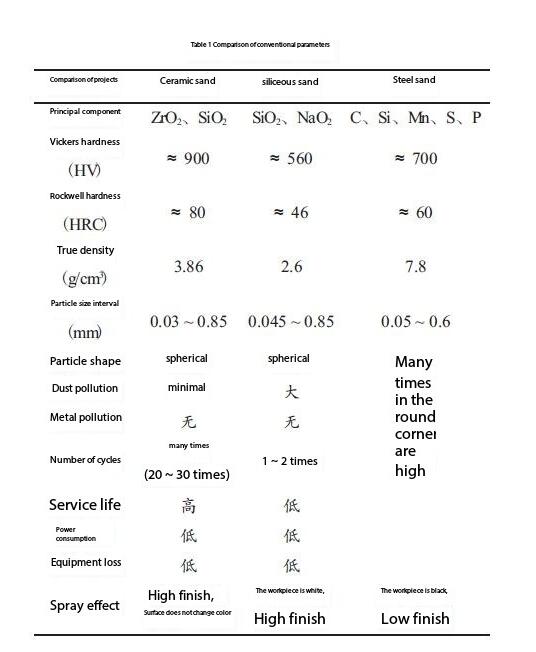Ceramic sandblasting involves high-pressure air jetting to impact and polish the surface of the workpiece, providing a fine treatment. It removes impurities, discoloration, and oxide layers from the surface while roughening the medium's surface, reducing residual stress on the workpiece and enhancing the substrate's hardness. This process enhances the aesthetics and durability of the object. In simple terms, its main functions include removing burrs, rust, oxidation, and dirt from the surface, preparing it for painting, improving surface hardness, and increasing surface roughness to enhance its visual appeal.
Burr Removal: Similar to conventional polishing, sandblasting removes surface burrs.
Dirt Removal: Common tasks include rust removal, oxidation layer removal, and the removal of dirt from molds. In essence, it eliminates unwanted elements, resulting in an even, bright, and beautiful appearance of the workpiece.
Pre-Painting Treatment: Using ceramic sand, it efficiently increases surface roughness, improving adhesion significantly, thus extending the lifespan of painting and electroplating.
Enhanced Surface Hardness: Sandblasting strengthening improves the mechanical properties of products. It is commonly used on the surfaces of components like aerospace parts and special gears.
Below are experiments conducted by our company:
We used a sandblasting machine with the same model, the same air pressure, the same blasting distance, and the same workpiece. We used sand of the same grain size but different sandblasting media to see the variations in workpiece treatment. We chose mechanical components made of stainless steel and titanium alloy for the tests.
Walnut shell sandblasting and plastic particle sandblasting: After impacting the test objects for 15 seconds using the same method, we checked the workpiece surfaces, and they remained essentially unchanged, while the sand had deformed.
Glass bead sandblasting: After 15 seconds of impact, we observed a slightly matte surface on the workpiece with a hint of brightness. Approximately 75% of the sand was broken and could not be reused.
Stainless steel or steel wire shot sandblasting: After 15 seconds of impact, we observed uneven blemishes on the workpiece surface, with no brightness or matte spots. The sand could be reused.
Corundum sandblasting: After 15 seconds of impact, we observed no matte or shiny spots on the workpiece surface.
Zirconium silicate bead sandblasting: After 15 seconds of impact, the workpiece surface was entirely matte and very smooth, with remarkable results. The sand was not broken and could be reused (approximately 20-30 times).
From these experiments, we can deduce the following:
Different sandblasting media have different effects on the workpiece. Kinetically speaking, with the same driving force, particles of the same diameter but different specific gravities will produce different speeds and impact forces, resulting in varying effects. The experiments proved that sandblasting beads, being spherical and smooth with high hardness and durability, are suitable for complex structures. They also eliminate stress and enhance the workpiece's lifespan.
Ceramic sand is usable, reduces the frequency of material changes, and improves production efficiency. It is not easily broken during sandblasting, produces no dust, and does not contaminate with metallic particles, making it a clean and safe choice, preventing the risk of occupational lung disease and protecting employee health.
Compared to glass sand, ceramic sand offers a higher level of cleanliness and a 20-fold increase in lifespan.
In comparison to steel shot, ceramic sand offers a finer surface texture, no iron element contamination on the workpiece, no metallic dust residue, and no discoloration. It restores the metal's original color.
With a density between glass sand and steel sand and higher hardness, ceramic sand is suitable for metal sandblasting strengthening and shaping, particularly for titanium and aluminum alloys.
Ceramic sand has a moderate quality and high hardness, making it an excellent choice for various applications.
It has no iron contamination, generates less dust, and provides a cleaner working environment with no harm to human health.
Ceramic sand maintains its shape and resists wear during use, ensuring consistent sandblasting results in batch production.
High spherical accuracy, smooth surface, and minimal equipment wear make ceramic sand an ideal choice."

Summary:
4.1 Cleaning and Polishing of Cast and Forged Surfaces
Sandblasting cleans all surface contaminants (e.g., oxides, oil residues) from cast and forged workpieces, providing a polished surface and enhancing its appearance.
4.2 Removal of Burrs and Surface Enhancement in Mechanical Components
Sandblasting removes small burrs from workpiece surfaces, creating smoother surfaces and improving workpiece quality. It also adds small rounded edges at workpiece junctions for a more appealing appearance and increased precision.
4.3 Improvement of Mechanical Component Performance
Sandblasting creates small and even surface irregularities on mechanical parts, allowing better lubrication and reducing noise, thereby enhancing the lifespan of the machinery. For specific applications, it can achieve various levels of reflectivity and matte finishes.
4.4 Stress Removal and Surface Strengthening
Sandblasting the workpiece surface removes surface stress, increasing surface strength and ensuring workpiece precision.

Submit your demand,
we will contact you ASAP.

Sanxin New Materials Co., Ltd. focus on producing and selling ceramic beads and parts such as grinding media, blasting beads, bearing ball, structure part, ceramic wear-resistant liners, Nanoparticles Nano Powder

